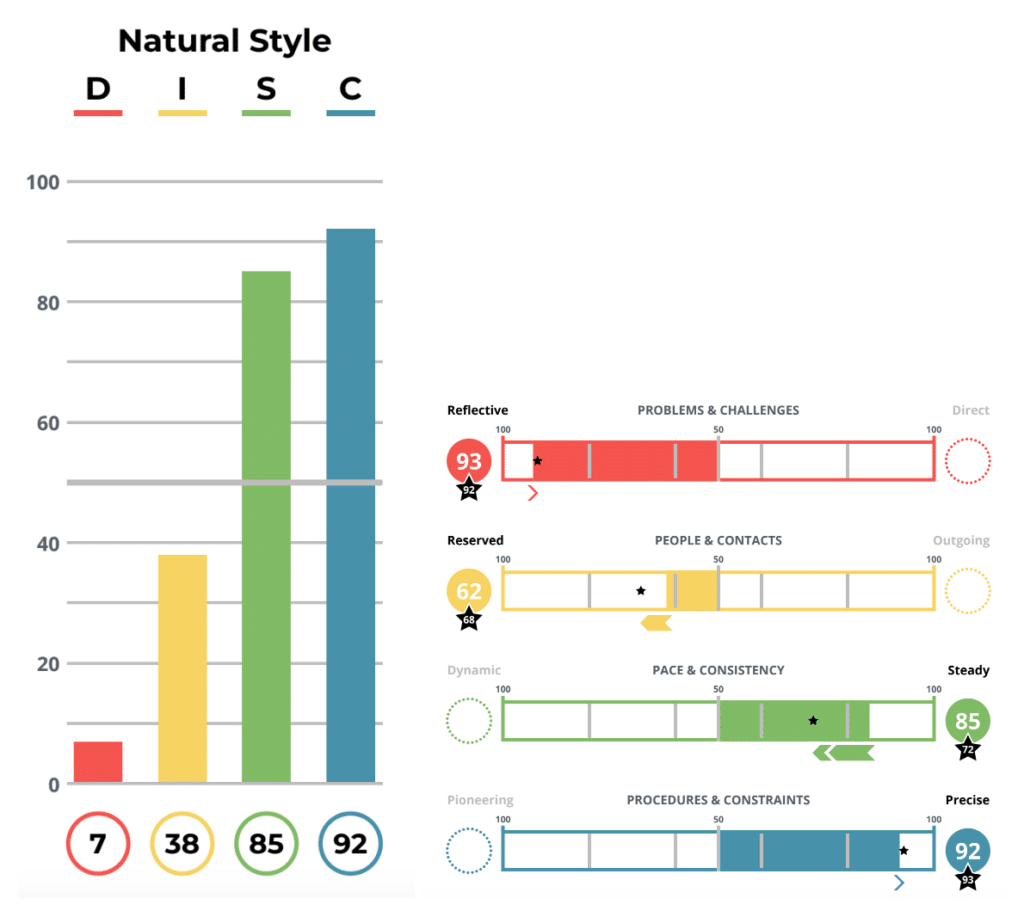On average, we speak at least 7,000 words a day. We spend the majority of our day communicating with other people. And everyone prefers to communicate differently. Some of us immediately say what’s on our minds while others are very intentional about what they say and when they say it. We maintain that most performance issues and disagreements at work are merely due to a failure to communicate. That’s why understanding your behavioral and communication style within the context of your DISC profile is an effective tool to help you better communicate at work.
The Four DISC Styles and How They Communicate
Before we jump into the four dimensions of DISC, let’s answer the question – “What is it?” A DISC assessment is a psychometric tool used to evaluate someone’s behavioral style and communication preferences. First introduced by William Moulton Marston in the 1920s, DISC is based on Marston’s study of behavior, and the assessment results explain the how behind your actions. DISC is the articulation of someone’s observable behavior.
DISC profiles can be used in a variety of ways throughout the employee lifecycle. It provides a data-based context for someone’s candidacy in an interview process, enhances their onboarding, and supports ongoing performance management and professional development. Knowing your own DISC profile, and being able to identify others’ preferred communication styles, allows you to adapt your communication effectively to be more productive.
DISC measures someone’s preferred communication style across four dimensions.
The four DISC dimensions are Dominance, Influence, Steadiness, and Compliance. Each person demonstrates a tendency towards each factor by degrees of intensity. Based on responses to a comprehensive assessment, the report outlines how a person is more likely to act based on their preferred communication style. An individual’s unique results, typically represented as a bar graph or a continuum, show their primary and secondary communication style and are indicative of how they prefer to communicate in given situations. Where an individual lands above or below the energy line in the bar graph and to the right or the left of the midpoint on the continuum demonstrates their DISC profile. Although the assessments are scientifically valid and reliable, they are just one tool and are not absolute. When helping someone understand their results, we communicate that their placement on the graph or continuum demonstrates how they prefer or are more likely to act.
Here’s an example of how a DISC report visualizes someone’s behavioral style –

Dominance
Your dominance factor, represented by the red bar, is how you respond to problems and challenges. Someone whose primary communication style is their dominance factor, represented by a D line above the energy line or to the right of the continuum, is considered a direct communicator. Direct communicators have a tendency to approach challenges aggressively. They are often described as bold and decisive. If you work with someone who leads with their dominance factor, you may observe them making quick decisions and focusing primarily on tasks. Direct communicators are commonly described as venturesome, pioneering, ambitious, strong-willed, and determined. They are typically fast-paced.
To effectively communicate with a direct communicator, keep meetings concise and focused because they focus on the efficiency of their and other’s time. Their assertiveness, bordering on aggressiveness, is not personal, and should not be taken that way. They are effective at keeping meetings on topic and driving themselves and the team toward results. Since they are focused on objectives, they are able to drive a team to win, because victory is in delivering effective, fast solutions. They have a developed sense of urgency and thrive in a fast-paced, results-driven environment.
On the other hand, someone whose dominance factor falls below the energy line is considered a reflective communicator. When it comes to addressing problems, challenges and conflict, reflective communicators may seem more hesitant to jump right into addressing them. They are more methodical and patient in their approach to problems. They are often slower to decide, especially compared to their direct communicator peers. Whereas direct communicators are fast-moving and competitive, the reflective communicator has a greater tendency to be easygoing and patient. To communicate with them effectively, don’t force them into a yes or no answer and give them time to listen and think before deciding on a course of action to solve a problem or address a conflict.
Influence
Someone’s influence factor tells you how they deal with people and connections. If someone’s I is above the energy line or to the right of the continuum, they are considered an outgoing communicator. Social capital is important to outgoing communicators and they are often optimistic, inspiring, and talkative. Those with a high influence factor are outgoing and demonstrative. In a meeting or a networking room, they are confident in talking to anyone and everyone. They ultimately build trust and are effective at persuading others through their ability to build relationships. Effective communication with outgoing communicators means giving them space to tell stories because they love being able to connect with the people around them. Interaction is essential for them, and they will always have questions and want to converse with you.
The opposite of an outgoing communicator is a reserved communicator, demonstrated by a bar below the energy line or to the left of the continuum. Whereas outgoing communicators have a tendency to jump right into relationships and trust, reserved communicators are more realistic and rational when it comes to relationship building. They are less quick to speak their minds because they are more logical and matter-of-fact when it comes to connecting with people, to the extent they may be perceived as pessimistic or suspicious. Effective communication with a reserved communicator looks like straightforward feedback, maintaining physical and emotional distance, and building trust based on objectives, not on emotions.
Steadiness
The steadiness factor graph provides insight into how someone manages pace and consistency. A steady communicator, or someone with an S factor above the energy line or to the right of the continuum, are your slower-paced, steady, and deliberate employees. They are your processors. They will be intentional about when, why and how they contribute. Steady communicators are able to separate emotions from decision-making. Steady communicators are the metaphorical “port in the storm.” When you’re attempting to communicate with a steady communicator, move at an even pace. Steady communicators prefer methodical change, rather than fast change for change’s sake, so try not to spring too much on them at once. Don’t force steady communicators to respond in meetings. They will share their thoughts when they are good and ready – and when they are confident their response is what the situation calls for.
Dynamic communicators, on the other hand, are your change agents in an organization. An S below the energy line and to the left of the continuum tends to be more impulsive. They are innovative and bring energy to a project. They navigate rapid change easily and tend to work faster than your steady communicators. They are flexible and can pull things together on the fly. If you’ve worked with a dynamic communicator, you most likely perceived them as active, mobile, and eager – maybe even “all over the place.” Effective communication with a dynamic communicator means keeping up with their rapid pace. They are your idea generators, so be willing to listen to what they have to say in rapid succession. You will most likely always know where you stand with a dynamic communicator, because they will tell you or you will be able to sense their emotions by what they say and how they say it.
Compliance
Finally, someone’s compliance factor relates to how they manage procedures and constraints. A precise communicator falls above the energy line and to the right of the continuum. They are detailed, organized, and analytical. They are your strategists and tend to dig deep beyond the surface. A precise communicator relies on facts, figures and data before moving forward. They believe in the importance of rules and following them. They thrive where there is structure and reliable systems. Quality is of the utmost importance to your “High C.” So, when communicating with them, focus on the facts and data of the situation. It’s difficult to persuade precise communicators without the benefit of supporting information. Setting clear expectations is an effective way to work with your colleagues who are above the energy line.
On the other hand, your pioneering communicators tend to be comfortable moving outside established rules. They may be seen as unconventional and independent. They are more prone to taking chances and may be perceived as a rule breaker. Pioneering communicators aren’t necessarily against rules or processes, they want to know they can be flexed if the situation warrants. Generally, pioneering communicators are seen as confident due to their ability to move forward quickly, whereas precise communicators take their time to analyze and evaluate all the information they can before making a decision. When communicating with a pioneering communicator, recognize they want the opportunity to be flexible, challenge the status quo, and think outside the box. They may not want to do things the way “they’ve always been done.” They respond well to people who move quickly and are decisive, rather than people who wait for all the data before making a move.
How DISC Can Help You Communicate More Effectively at Work
As you see, even among the 4 dimensions of DISC, there are variations in how someone will behave and communicate at work. And DISC is just one behavioral assessment. Although it is a highly effective tool when used properly, it is not the definitive resource for determining how someone will perform in their job. However, having employees complete a DISC assessment and completing a debrief with a certified consultant helps employers provide greater context to how every member of their team behaves.
Once you know someone’s primary communication style, you can adapt as needed to ensure effective communication across all levels of the organization. If you have a member of your team who always starts the meeting with a personal story, you can associate that with the fact they are an outgoing communicator. It may not be the most effective use of your time, but it’s important for that employee to connect socially with the team before jumping right into business. Similarly, if your manager is a known direct communicator, you can adapt to the fact their abrupt style isn’t personal. It’s just the way they prefer to communicate.
The great thing about DISC assessments is that they are an assessment, not a test. There are no right or wrong answers. And any qualified consultant will tell you that there is no “right” or “wrong” profile. The profile merely tells you how you prefer to communicate and how that impacts the work you do. And once you know your own style, you can adapt to the diverse styles around you. It established a baseline as to how everyone can best communicate which, in turn, improves productivity.
Consult With a DISC Assessment Provider
Red Clover is a value-added partner with our vetted assessment provider TTI Success Insights. Internally, we’ve integrated DISC (as well as Driving Forces and EQ) into our recruitment, onboarding, and performance management processes. We actively fight against the stigma associated with psychometrics in the HR community, because we know how to use the tool effectively and compliantly If you’re looking to integrate data-driven assessments across your employee lifecycle, Red Clover is your trusted partner. Reach out today.
Photo Credit – Photo by Jason Leung on Unsplash



